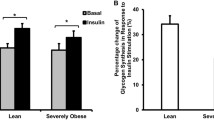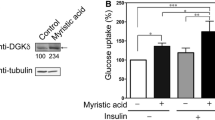Abstract
Previous investigation demonstrated the potential of L-cysteine (L-Cys) at high concentrations to cause hypoglycemia in mice totally deprived of insulin. For further elucidation of the glucose-lowering mechanism, glucose uptake and quantity of glucose transporters (GLUTs 3 and 4) in mouse soleus muscle and C2C12 muscle cells, as well as in human SH-SY5Y neuroblastoma cells, were investigated. A marked enhancement of glucose uptake was demonstrated, peaking at 5.0 mM L-Cys in soleus muscle (P < 0.05) and SH-SY5Y cells (P < 0.001), respectively. In contrast, glucose uptake was not affected in the C2C12 muscle cells. Kinetic analysis of the SH-SY5Y glucose uptake showed a 2.5-fold increase in maximum transport velocity compared with controls (P < 0.001). In addition, both GLUT3 and GLUT4 levels were increased following exposure to L-Cys. Our findings point to a possible hypoglycemic effect of L-Cys.
Similar content being viewed by others
References
Auer, R.N. (1986). Progress review: Hypoglycemic brain damage. Stroke 17:699-708.
Back, S.A., Khan, R., Gan, X., Rosenberg, P.A., and Volpe, J.J. (1999). A new Alamar Blue viability assay to rapidly quantify oligodendrocyte death. J. Neurosci. Methods 91:47-54.
Boyle, P.J., Kempers, S.F., O'Connor, A.M., and Nagy, R.J. (1995). Brain glucose uptake and unawareness of hypoglycemia in patients with insulin-dependent diabetes mellitus. N. Engl. J. Med. 333:1726-1731.
Bradford, M.M. (1976). A rapid and sensitive method for the quantitation of microgram quantities of protein utilizing the principle of protein-dye binding. Anal. Biochem. 72:248-254.
Brozinick, J.T., Jr., Etgen, G.J., Jr., Yaspelkis, B.B, III, and Ivy, J.L. (1994). The effects of muscle contraction and insulin on glucose-transporter translocation in rat skeletal muscle. Biochem. J. 297:539-545.
Charron, M.J., and Kahn, B.B. (1990). Divergent molecular mechanisms for insulin-resistant glucose transport in muscle and adipose cells in vivo. J. Biol. Chem. 265:7994-8000.
Do, K.Q., Mattenberger, M., Streit, P., and Cuénod, M. (1986). In vitro release of endogenous excitatory sulfur-containing amino acids from various rat brain regions. J. Neurochem. 46:779-786.
Gazit, V., Taha, A., Pick, C.G., Rozenberg, B., and Katz, Y. (1995). L-Cysteine induces a long-term neurobehavioral injury in mice [Abstract]. Isr. J. Med. Sci. 31:762.
Kahn, B.B. (1992). Facilitative glucose transporters: Regulatory mechanisms and dysregulation in diabetes. J. Clin. Invest. 89:1367-1374.
Kamei, Y., Tsutsumi, O., Yamakawa, A., Oka, Y., Taketani, Y., and Imaki, J. (1999). Maternal epidermal growth factor deficiency causes fetal hypoglycemia and intrauterine growth retardation in mice: Possible involvement of placental glucose transporter GLUT3 expression. Endocrinology 140:4236-4243.
Kotliar, N., and Pilch, P.F. (1992). Expression of the glucose transporter isoform GLUT 4 is insufficient to confer insulin-regulatable hexose uptake to cultured muscle cells. Mol. Endocrinol. 6:337-345.
Lund, S., Flyvbjerg, A., Holman, G.D., Larsen, F.S., Pedersen, O., and Schmitz, O. (1994). Comparative effects of IGF-I and insulin on the glucose transporter system in rat muscle. Am. J. Physiol. 267:E461-E466.
Matthews, C.C., Odeh, H.M., and Feldman, E.L. (1997). Insulin-like growth factor-I is an osmoprotectant in human neuroblastoma cells. Neuroscience 79:525-534.
Mueckler, M., Caruso, C., Baldwin, S.A., Panico, M., Blench, I., Morris, H.R., Allard, W.J., Lienhard, G.E., and Lodish, H.F. (1985). Sequence and structure of a human glucose transporter. Science 229:941-945.
Olney, J.W., and Ho, O.-L. (1970). Brain damage in infant mice following oral intake of glutamate, aspartate or cysteine. Nature 227:609-611.
Olney, J.W., Zorumski, C., Price, M.T., and Labruyere, J. (1990). L-Cysteine, a bicarbonate-sensitive endogenous excitotoxin. Science 248:596-599.
Stein, W.D., Eilam, Y., and Lieb, W.R. (1974). Active transport of cations across biological membranes. Ann. N. Y. Acad. Sci. 227:328-336.
Strout, H.V., Vicario, P.P., Biswas, C., Saperstein, R., Brady, E.J., Pilch, P.F., and Berger, J. (1990). Vanadate treatment of streptozotocin diabetic rats restores expression of the insulin-responsive glucose transporter in skeletal muscle. Endocrinology 126:2728-2732.
Suzuki, K., and Kono, T. (1980). Evidence that insulin causes translocation of glucose transport activity to the plasma membrane from an intracellular storage site. Proc. Natl. Acad. Sci. U.S.A. 77:2542-2545.
Thorens, B., Charron, M.J., and Lodish, H.F. (1990). Molecular physiology of glucose transporters. Diabetes Care 13:209-218.
Tortorella, L.L., and Pilch, P.F. (2002). C2C12 myocytes lack an insulin-responsive vesicular compartment despite dexamethasone-induced GLUT4 expression. Am. J. Physiol. Endocrinol. Metab. 283(3):E514-E524.
Walum, E., and Edström, A. (1976). Kinetics of 2-deoxy-D-glucose transport into cultured mouse neuroblastoma cells. Exp. Cell Res. 97:15-22.
Zhang, J.Z., Behrooz, A., and Ismail-Beigi, F. (1999). Regulation of glucose transport by hypoxia. Am. J. Kidney Dis. 34:189-202.
Zivin, J.A., and Waud, D.R. (1982). How to analyze binding, enzyme and uptake data: The simplest case, a single phase. Life Sci. 30:1407-1422.
Author information
Authors and Affiliations
Rights and permissions
About this article
Cite this article
Gazit, V., Ben-Abraham, R., Vofsi, O. et al. L-Cysteine Increases Glucose Uptake in Mouse Soleus Muscle and SH-SY5Y Cells. Metab Brain Dis 18, 221–231 (2003). https://doi.org/10.1023/A:1025507216746
Issue Date:
DOI: https://doi.org/10.1023/A:1025507216746




